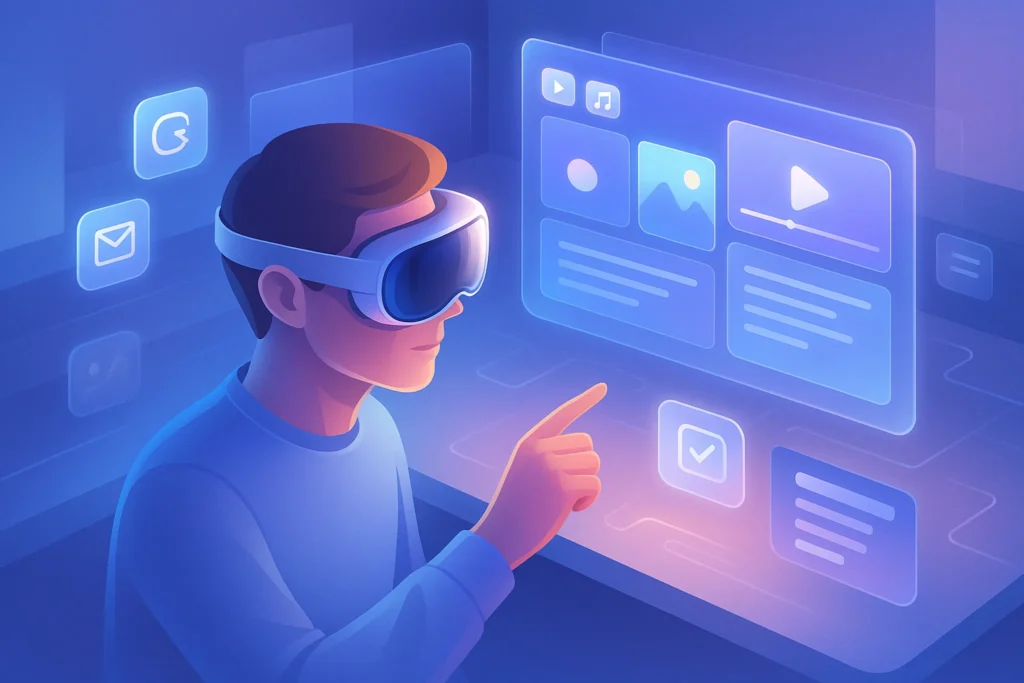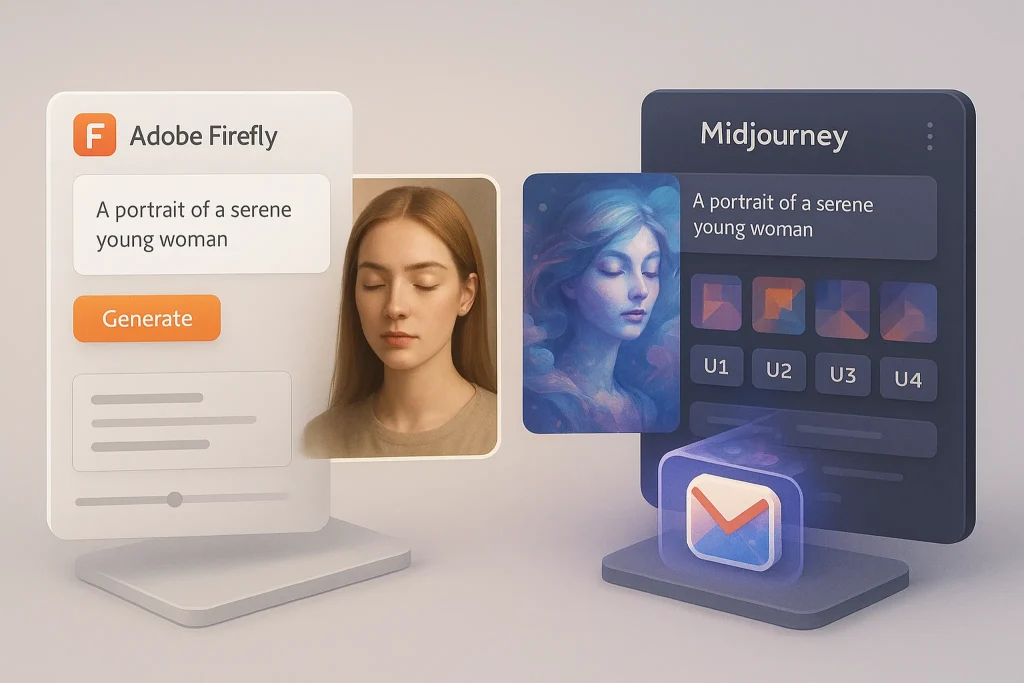-This post may contain affiliate links. If you click on one and make a purchase, I may earn a small commission at no extra cost to you.-
🧠 Introduction
Apple calls the Vision Pro “the era of spatial computing”. But does this breakthrough AR/VR headset truly redefine the way we interact with digital content? In this review, we’ll dive deep into its premium build, cutting-edge hardware, visionOS interface, performance across productivity and entertainment, and judge whether it puts spatial computing within reach—or remains a luxury niche.
While Apple Vision Pro pushes the boundaries of mixed reality with its high-end visuals and spatial computing, it’s not the only player shaping the future of immersive gaming. If you’re more interested in untethered, affordable VR experiences built specifically for gamers, the Oculus Quest 3 offers a fresh perspective on how Meta is redefining standalone VR headsets in 2025.
🎨 Design & Comfort
Premium Build and Fit
-
Composed of laminated glass, aluminum frame, and soft knit seal—ensures snug fit .
-
Two interchangeable bands (Solo Knit and Dual Loop) cater to either quick use or longer sessions.
Weight Concerns
-
At 590–650 g, it feels noticeably heavier than competing headsets (e.g., Meta Quest 3, 1.1 lb).
-
Extended wear causes cheek soreness and periodic discomfort—a fact echoed in multiple reviews.
Fit Customization
-
Apple’s Light Seal is custom-molded via Face ID‑style scan—effectively blocks stray light but may cause pressure marks.
Modular Fit Options
- Vision Pro’s interchangeable Solo Knit and Dual Loop bands let users switch between lightweight convenience and secure stability. Many reviewers note having to adjust the dual-loop strap frequently, especially during long sessions. This suggests Apple still needs to refine fit consistency.
Weight Distribution & Accessories
- Weighing 21.2–22.9 oz (600–650 g) without battery, the device feels like “strapping an iPad Pro to your face”. Ergonomic accessories released during the year (like counterweight attachments) improve balance. However, most users max out at 2-hour continuous usage before fatigue forces a break .
Nerd Verdict: Sleek and well-built, but the weight makes comfort a mixed bag, especially for multi-hour use.
🔦 Display & Spatial Audio
- Micro‑OLED Brilliance
-
Dual micro‑OLED screens deliver more pixels than a 4K TV per eye.
-
Visual clarity is unmatched—reviews praise it as “best displays I’ve ever seen in a headset” .
Spatial Audio Immersion
-
Audio pods with around-ear spatial audio and six-mic beamforming offer immersive, yet aware sound.
-
Sound is clear and positional; you can still hear ambient noise—a feature enjoyed in mixed reality apps.
Ultra‑High Resolution & Field‑of‑View
-
With ~3,660×3,200 micro-OLED per eye and ~3 K PPI, the displays outperform all previous headsets . The adjustable refresh rate (90/96/100 Hz) contributes to fluid visuals, but field-of-view (~100°×73°) remains narrower than some competitors.
Spatial Audio Sensitivity
-
Users mention how well Vision Pro balances immersive audio with spatial awareness—critical when discussing surround sound enjoyment but avoiding full auditory isolation.
🧭 visionOS & Interaction
Intuitive Controls
-
Operated via eye tracking, hand gestures (“pinch”, “swipe”), and voice commands. Even tweeting feels futuristic.
-
UI elements activate on gaze with subtle animations, gestures become second nature.
EyeSight and Social UX
-
Outward-facing display reveals your eyes during immersion—enabling more natural interactions.
-
Video calls via FaceTime feel especially immersive, with 3D tiles and dynamic spatial audio.
App Ecosystem
-
Supports Apple’s built-in apps plus iPad/Mac compatibility and visionOS‑native ones.
-
Spatial photos, movies, multitasking with floating apps, Mac Virtual Display: all work smoothly but app library remains thin.
Interface Smoothness & Latency
- Vision Pro’s R1 chip keeps latency to ~12 ms—eight times faster than a blink. However, some users report visionOS glitches or freezes during everyday use, suggesting room for software refinement.
EyeSight & Persona
- EyeSight projects your eyes outward for social transparency; though effective, some reviews describe the external display as “creepy” or awkward in social settings. Persona avatars are impressive but fall into the uncanny valley, with reports of aging or unnatural rendering .
Typing & Text Input
- Text entry via floating keyboard feels slow and unintuitive—better suited for light text than lengthy work . Pairing a Bluetooth keyboard is recommended whenever serious typing is needed.
🧩 Real‑World Use Cases
-
Productivity:
-
Virtual Mac displays (equivalent to dual 5K monitors) are crisp and usable even for productivity.
- visionOS behaves like a virtual multi-monitor hack portable across spaces. Temporary sessions up to 3 hours work well, but neck strain becomes real as time passes .
-
-
Creativity & Capturing Moments:
-
Built‑in 3D cameras capture spatial photos/videos. Reliving memories literally around you is an emotional draw.
-
-
Professional/Enterprise:
-
Early adopters in design, architecture, and collaboration find value—Tim Cook emphasized developers as first users.
-
-
Entertainment & Movies
-
Reviewers describe watching in 3D as “jaw-dropping,” with headset-feeling approaching theater immersion . Watching 3D movies like Super Mario or sports reels captures attention like no other device .
-
Creative Applications
-
Apps like djay, SkyGuide, and JigSpace show potential for hands-on spatial interaction. However, the app catalog remains limited—native experiences are “modest” but immersive, and blockbusters like Netflix/YouTube are still absent from visionOS.
⚙️ Performance & Battery Life
Power & Latency
-
Dual‑chip architecture: M2 manages UI and apps, R1 handles sensor input with 12 ms latency.
-
Performance reportedly smooth—software is light but stable .
- Reliable But Not Unflappable
Users report smooth handling of multitasking, video playback, and spatial applications. Some issues—like app freezes or OpticID hiccups—are intermittent but frustrating.
Battery Life
-
Packs provide: ~2 hours general use, 2.5 hours video playback.
-
Battery cable trend receives criticism; users must manage swapping or tethering.
-
Battery Usability
The external 35.9 Wh battery supports 2-hour general use and 2.5 hours of video. While tethered use is manageable at a desk, mobility is hampered by battery bulk and cable concerns.
Nerd Verdict: Groundbreaking hardware, but short battery life and tethered power are limiting factors for on-the-go use.
⚠️ Limitations & Drawbacks
-
$3,499 starting price, additional lenses, battery holders, and AppleCare add thousands.
-
App ecosystem immature, third-party support still growing.
-
Weight & comfort concerns limit session duration.
-
Battery and mobility limitations hamper portability .
-
User isolation due to headset barrier—shared experiences feel awkward.
-
High Price & Accessibility
The $3,499 entry point (plus additional gear) places the Vision Pro firmly in the early-adopter category. -
Immature App Ecosystem
With around 600 native visionOS apps initially evolving to over 2,500, users still find the variety lacking compared to mainstream platforms . -
Strain & Social Isolation
Shoulder and neck discomfort after 2–3 hours is common—even among enthusiastic users . Early adopters in public settings report social awkwardness or feeling like a spectacle.
🧠 Nerd Verdict
The Apple Vision Pro is a remarkable first chapter in spatial computing. Its visuals, gesture control, and spatial audio feel straight out of sci-fi. It’s ideal for those seeking immersive viewing, creative capture, or productivity in virtual environments.
-
Groundbreaking: Vision Pro unmistakably sets a new benchmark for AR/VR experiences with unmatched display, audio, and spatial input.
-
Niche Appeal: As a developer and innovation testbed, it excels. But for everyday users, price, comfort, and ecosystem maturity hold back broad adoption.
-
Room to Grow: Features like Persona and EyeSight show potential, but both need refinement before becoming polished consumer tech.
But as a consumer device, its $3.5K price, brief battery life, and weight hold users back. It’s a powerful developer-first tool, not a mass-market or casual headset—yet. Those willing to invest will glimpse the future; others may prefer to wait for lighter, cheaper next-gen successors.
Apple’s leap into spatial computing raises a broader question: where exactly is immersive technology headed? From enterprise-level AR to consumer-first VR, the field is evolving fast. For a wider look at trends shaping the industry, you might want to check out AR and VR: The State of Immersive Tech—a deep dive into the current landscape and what lies ahead.
🎁 Bonus: What Vision Pro Reveals About Apple’s Broader AR Future
While the Vision Pro steals the spotlight in hardware, it’s Apple’s broader ecosystem that’s quietly laying the groundwork for more immersive, integrated experiences. The upcoming iOS 26 ‘Liquid Glass’ update introduces interface elements clearly optimized for spatial interaction—like floating UI layers, translucent widgets, and eye-guided gestures.
If you’re curious how Apple is shaping the software side of spatial computing, our full breakdown of the iOS 26 update dives into the features, vision, and implications for the next generation of devices.
❓ FAQ
Q: Is the Vision Pro worth it in 2025?
A: Yes, if price isn’t a constraint and you value immersive productivity, cinema, and spatial creativity. For casual users, the cost-benefit is still steep.
Q: How long does the battery last?
A: Roughly 2 hours for daily use, 2.5 hours for video—beyond that, you’ll need to swap battery packs or plug in.
Q: Can I wear it with glasses?
A: Yes—magnetic prescription inserts available ($99 for readers, $149 for prescription).
Q: Is it suitable for gaming?
A: Not optimized for fast-paced VR gaming; better suited for casual or immersive experiences. Game compatibility is limited compared to Quest headsets.
Q: Is the weight a deal-breaker?
A: Comfort varies: many users need breaks during long sessions; for some, periodic red marks or pressure are bothers.
Q: What’s the real-world wearing time?
A: Most can comfortably wear it for ~2 hours; anything longer may cause strain .
Q: Can I use it outdoors?
A: Passthrough video quality is impressive, but bright sunlight may cause glare or wash out visuals.
Q: Is spatial audio private enough?
A: Audio is directed carefully, but sound does leak—use AirPods for total privacy
💬 Would You Bite?
Would you invest $3,499 in the future of spatial computing today?
Share your take—are you ready to wear the future, or holding out for lighter, cheaper options? 👇



